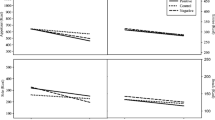Abstract
This study investigated the association of dietary restraint and disinhibition with self-reported and actual eating behavior, body mass, and hunger. A sample of 124 women were categorized into one of four groups based upon high and low scores on measures of Dietary Restraint and Disinhibition using the Three Factor Eating Questionnaire. Half of the participants in each group consumed a high sugar/high fat chocolate pudding as a dietary preload. All participants were given a meal comprised of a standard macaroni and beef product. The interaction of Dietary Restraint and Disinhibition was related to differences in body mass. The Dietary Restraint factor was related to self-reported pathological eating behavior and influenced both perceived hunger and subjective hunger ratings. However, actual eating behavior measured by calories consumed and rate of intake was unrelated to the Dietary Restraint factor. Disinhibition was associated with excessive eating, an increased rate of eating, self-reports of eating disorder symptomatology, and perceived hunger. Hence, actual eating behavior was significantly influenced by the ingestive motivational factor, Disinhibition, but not by the cognitive factor, Dietary Restraint. These data also suggest that the Disinhibition construct is measuring overeating rather than disinhibited eating which implies the disruption of Dietary Restraint.
Similar content being viewed by others
References
Herman C.P., Mack D.: Restrained and unrestrained eating. J. Pers., 43, 647–660, 1975.
Herman C.P., Polivy J.: Anxiety, restraint, and eating behavior. J. Abnorm. Psychol., 84, 666–672, 1975.
Hibscher J.A., Herman C.P.: Obesity, dieting, and the expression of “obese” characteristics. J. Comp. Physiol. Psychol., 91, 374–380, 1977.
Heatherton T.R., Polivy J.: Chronic dieting and eating disorders: A spiral model. In: Crowther J.H., Hobfall S.E., Stephens M.A.P., Tennenbaum D.L. (Eds.), The etiology of bulimia: The individual and familial context. Washington, DC, Hemisphere, 1992, pp. 133–135.
Ruderman A.J.: Dietary restraint: A theoretical and empirical review. Psychol. Bull., 99, 247–262, 1986.
Lowe M.R.: The effect of dieting on eating behaviors: A three-factor model. Psychol. Bull., 114, 100–121, 1993.
Stunkard A.J., Messick S.: The three-factor eating questionnaire to measure dietary restraint, disinhibition and hunger. J. Psychosom. Res., 29, 71–83, 1985.
Pirke K.M., Laessle R.G.: Restrained eating. In: Stunkard A.J., Wadden T.A. (Eds.) Obesity: Theory and Therapy, 2nd ed. New York, Raven Press, 1993, pp. 151–162.
Westenhoefer J., Broeckman P., Munch A.K., Pudel V.: Cognitive control of eating behaviour and the disinhibition effect. Appetite, 23, 27–41, 1994.
Williamson D.A., Lawson O.J., Brooks E.R., Wozniak P.J., Ryan D.H., Bray G.A., Duchmann E.G.: Association of body mass with dietary restraint and overeating. Appetite, 25, 31–41, 1995.
Fanchina J.J., Slank K.L.: Effects of deprivation on salivary flow in the apparent absence of food stimuli. Appetite, 10, 143–147, 1988.
Wooley S.C., Wooley O.W.: Salivation to the sight and thought of food. Psychosom. Med., 35, 136–142, 1973.
American Psychiatric Association: Diagnostic and statistical manual of mental disorders, ed. 4. Washington, D.C., American Psychiatric Press, 1994.
Allison D.A., Kalinsky L.B., Gorman B.S.: A comparison of the psychometric properties of three measures of dietary restraint. Psychological Assessment, 4, 391–398, 1992.
Laessle R.G., Tuschl R.J., Kotthaus B.C., Pirke K.M.: A comparison of the validity of three scales for the assessment of dietary restraint. J. Abnorm. Psychol., 98, 504–507, 1989.
Williamson D.A., Anderson D.A., Gleaves D.H.: Anorexia and bulimia nervosa: Structured interview methodologies and psychological assessment. In: Thompson K. (Ed.) Body image, eating disorders, and obesity: A practical guide for assessment and treatment. California, Sage, 1996, pp. 205–224.
Garner D.M., Garfinkel P.E.: The eating attitudes test: An index of the symptoms of anorexia nervosa. Psychol. Med., 9, 273–279, 1979.
Thelen M.H., Farmer J., Wonderlich S., Smith M.: A revision of the Bulimia Test: The BULIT-R. Psychological Assessment, 3, 119–124, 1991.
Peck R.E.: The SHP Test: An aid in the detection and measurement of depression. Arch. Gen. Psychiatry, 1, 35–40, 1959.
Kissileff H.R., Klingsberg G., Van Itallie T.B.: Universal eating monitor for continuous recording of solid or liquid consumption in man. Am. J. Physiol., 238, 14–22, 1980.
Geiselman P.J., Smith C.F., Williamson D.A., Champagne CM, Bray G.A., Ryan D.H.: Perception of sweetness intensity determines women’s hedonic and other perceptual responsiveness to chocolate food. Appetite, in press.
Lawson O.J., Williamson D.A., Champagne C.M., Delany J.P., Brooks E.R., Howat P.M., Wozniak P.J., Bray G.A., Ryan D.H.: The association of body weight, dietary intake, and energy expenditure with dietary restraint and disinhibition. Obes. Res., 3, 153–161, 1995.
Westenhoefer J., Pudel V., Maus N.: Some restrictions on dietary restraint. Appetite, 14, 137–141, 1990.
Hill S.W., McCutcheon N.B.: Contributions of obesity, gender, hunger, food preference, and body size to bite size, bite speed, and rate of eating. Appetite, 5, 73–83, 1984.
Author information
Authors and Affiliations
Rights and permissions
About this article
Cite this article
Smith, C.F., Geiselman, P.J., Williamson, D.A. et al. Association of dietary restraint and disinhibition with eating behavior, body mass, and hunger. Eat Weight Disord 3, 7–15 (1998). https://doi.org/10.1007/BF03354907
Received:
Accepted:
Published:
Issue Date:
DOI: https://doi.org/10.1007/BF03354907




